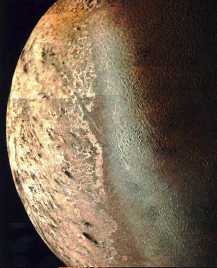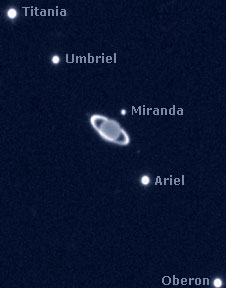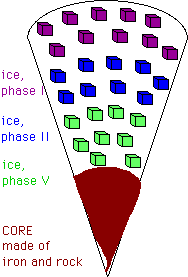This is an image of Triton, Neptune's largest moon. The image was taken by the Voyager 2 spacecraft in August 1989.
Click on image for full size
NASA
Neptune's Moons and Rings
Neptune has
moons. As is the case with all of the gas giant planets in our Solar System, it also has a series of rings.
Neptune's ring system is very different from the ring system found at Saturn. Neptune's rings are much darker than Saturn's bright rings. Saturn's rings are mostly composed of ice, whereas Neptune's appear to be made of small rocks and dust.
Neptune has one very large moon named Triton.
Triton is one of the coldest places in the Solar System. However, Triton appears to be geologically active. It has active geysers, similar to those found at Yellowstone Park on Earth, but Triton's geysers spew out ice instead of steam. Triton may also have a water environment like that of Earth's north pole.
This liquid environment might be suitable for the existence of life.
This icy moon has a very thin atmosphere and
an interior which may be active.
The rest of Neptune's moons are much smaller than Triton. Nereid was
discovered by Gerard Kuiper in 1949.
Despina, Galatea, Larissa, Naiad, Proteus and Thalassa were discovered by
the Voyager 2 spacecraft in 1989.
Five more small moons have been discovered
recently; three in 2002 and two
more in 2003. The most recently discovered moons don't yet have official
names.
The Moons of Neptune
Ordered by Size
|
| Name |
Size
(diameter or dimensions)
|
| Triton |
2,706.8 km
|
| Proteus |
220 x 208 x 202 km
|
| Nereid |
340 km
|
| Larissa |
108 x 102 x 84 km
|
| Galatea |
102 x 92 x 72 km
|
| Despina |
90 x 74 x 64 km
|
| Thalassa |
54 x 50 x 26 km
|
| Naiad |
48 x 30 x 26 km
|
| S/2002 N4 |
60 km
|
| S/2002 N1 |
48 km
|
| S/2002 N2 |
48 km
|
| S/2002 N3 |
48 km
|
| S/2003 N1 |
28 km
|
|
� |
Ordered by
Distance from Neptune
|
| Name |
Average Distance
from Neptune's center
|
| Naiad |
48,227 km
|
| Thalassa |
50,075 km
|
| Despina |
52,526 km
|
| Galatea |
61,953 km
|
| Larissa |
73,548 km
|
| Proteus |
117,647 km
|
| Triton |
354,760 km
|
| Nereid |
5,513,400 km
|
| S/2002 N1 |
15,686,000 km
|
| S/2002 N2 |
22,452,000 km
|
| S/2002 N3 |
22,580,000 km
|
| S/2002 N4 |
46,570,000 km
|
| S/2003 N1 |
46,738,000 km
|
|
You might also be interested in:

How did life evolve on Earth? The answer to this question can help us understand our past and prepare for our future. Although evolution provides credible and reliable answers, polls show that many people turn away from science, seeking other explanations with which they are more comfortable.
...more
Triton is a little bit like Jupiter's moon Europa, and a little bit like Saturn's moon Titan. There is a very thin atmosphere which is a bit like Titan's. It is very cold, about -300 degrees. Like the
...more
Gerard Kuiper was an American astronomer who lived between 1905-1973. He is considered the father of modern planetary science for his brilliant study of our solar system. Kuiper developed a new technique
...more
Astronomers have discovered new moons orbiting Uranus and Neptune. 2003 has been a banner year for moon discoveries; several new moons orbiting Jupiter, Saturn, and Neptune were announced earlier this
...more
It seems that global warming is not simply constrained to the Earth. Observations taken by the Hubble telescope show that Neptune's largest moon, Triton, has heated up since the Voyager spacecraft flew
...more
Triton was discovered by W. Lassell in 1846. Of the 8 moons, it is the 2nd farthest from Neptune, with a standoff distance of 354,800 km. Triton may be one of the largest of the icy moons, is comparable
...more
Composition is generally determined by detailed measurements of the spectra of an object. Spectral measurements of the surface of Triton reveal the presence not only of ice but of several different kinds
...more
The diagram to the left shows a cutaway of the possible interior structure of Triton. The composition of Triton is mostly ice, therefore there is probably a small core of some rocky material buried inside,
...more











